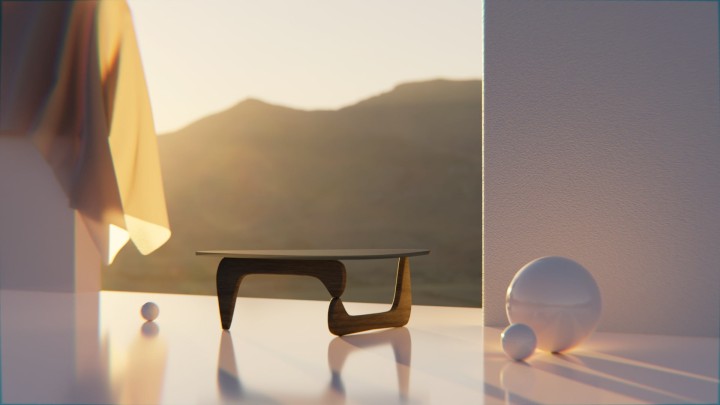Isamu Noguchi: Exhibition in Cologne until 31.07.2022
The Museum Ludwig in Cologne is showing works by the sculptor Isamu Noguchi (1904-1988), a retrospective of 150 works from the fields of art, garden and design from Europe, including several creative periods of the politically committed artist. In addition to Rita Kersting from the Museum Ludwig, the exhibition was curated by colleagues from Bern, London and Lille and financially supported by the Isamu Noguchi Foundation and the Garden Museum (New York City). The aim of the Cologne exhibition is to make visible an artist whose far-sightedness has unjustly led him to be somewhat lost in art history.
A landscape architect, sculptor and stage designer is born
Isamu Noguchi was born in
Los Angeles on 17 November 1904. His mother Léonie Gilmour (an American author) was abandoned by his father Yonejirō Noguchi (a Japanese poet) before he was born and moves to Tokyo with her son. Isamu attends schools in Chigasaki and Yokohama until 1917. In 1918 he travels alone to America under the name Sam Gilmour to attend the Interlaken School in Indiana. He soon dropped out of medical school at Columbia University (New York). He secured his livelihood with portrait work and financed sculpture courses with Onorio Ruotolo (1888-1966). In 1927 he received a Guggenheim Fellowship and worked in the studio of the sculptor Constantin Brâncuși (1876-1957) in Paris.
Isamu Noguchi: The Designer
Isamu Noguchi became famous for his Vitra Coffee Table and the Akari lamps. The Coffee Table side table was designed in 1944 and has been manufactured in the USA by Herman Miller since 1947. The expressive table has only been available in Europe since 2002. Isamu Noguchi focused on strong organic forms (sculptures), which were typical of midcentury design. The special feature of the Coffee Table lies in its formal language, which reveals the sculptor. With this piece of furniture - which Noguchi called his best design - the sculptor climbed the Olympus of designers. The base of the table consists of two identical wooden elements, the tabletop of tempered glass. The Akari Light Sculptures were created in 1951 on one of his trips to Japan. In the city of Gifu, he sketched his first Akari Light Sculpture, later he created more than a hundred table lamps, floor lamps and ceiling lamps up to a size of 290 centimetres. You can find some of the Akari lamps and the famous Vitra Coffee Table in your pro office shop.
Isamu Noguchi in Europe
In addition to the Vitra Coffee Table and the Akari lamps, there were works in Europe that raised the artist's profile: a stainless steel sculpture in the American pavilion for the 1958 Expo in Brussels, sheet aluminium art for the "UNESCO Garden" and participation in documenta II and III in Kassel in 1959 and 1964. Isamu Noguchi's first solo exhibition in Europe was in 1974 at the Galerie Claude Bernard in Paris. In the same year, the exhibition "Japan: Tradition and Present" opened at the Kunsthalle Düsseldorf. In 1986, "Playscapes in Piedmont Park in Atlanta" was shown at the Danish Museum of Modern Art. In the same year, Noguchi represented the United States at the Venice Biennale. There, some of his sculptures in stone, metal and paper are exhibited in the American pavilion.
Philosophy and Politics
Isamu Noguchi believed in natural materials, technological progress and wanted to improve the reality of people's lives. Through his experiences as a bright-eyed person in Japan, the son of an American mother and a Japanese father felt himself to be a cosmopolitan without a home, perhaps a prerequisite for breaking artistic disciplines several times. The artist stood up against fascism, exploitative capitalism, poverty and racism. His sculptures are considered both painful but equally humorous and playful. Despite difficult experiences (voluntary internment), he did not believe in suffering but in lightness. Isamu Noguchi voluntarily interned himself in 1942 after the attack on Pearl Harbour in order to show solidarity with and support the other 120,000 Americans with Japanese roots.
Dropping the first atomic bomb
Isamu Noguchi was ahead of his time in feeling that everything on earth was connected. Shortly after the dropping of the first atomic bomb, he visited Hiroshima, from the site of the gigantic cemetery. Under this disturbing impression, the "Memorial to Man" was created in 1947 for an imagined civilisation looking down on a deserted Earth from the planet Mars.
Friends and colleagues for life In 1929, Noguchi met the engineer R. Buckminster Fuller and the dancer and choreographer Martha Graham, who would accompany him throughout his life with various projects. Graham (1894-1991) is considered the most important founder of modern dance, which is characterised by openness to other cultures and influences and puts physical expression before technical perfection (dance as the language of the soul). He designed the first stage set for a dance performance for Martha Graham in 1935/36. From 1944 onwards, others followed, including the Hérodiade, a well-known opera in four acts by Jules Massenet.
Systemic work and global perspectives
Richard Buckminster Fuller (1895-1983) worked as an architect, designer and builder without a degree. As a visionary, he developed geodesic domes, so-called Fuller domes, which are based on geometric bodies and are extremely stable with a low material input, as is the energy-saving Fly's Eye Dome developed in 1965. Like Noguchi, Fuller was concerned with systemic action, global and cosmic perspectives and coined the term "synergies". Like Noguchi, he wanted to avoid cosmic bankruptcy, propagated sustainable development and showed how spontaneous cooperation can improve the lives of all people. The collaboration between the two artists resulted in the Bakelite case for alarm clocks and the Dymaxion Car. Noguchi also became friends with Frida Kahlo, whom he met while making the wall relief "History Mexico" in Mexico City.
Ups and downs and many journeys between worlds
In 1938 Noguchi received his first major commission in the USA, the relief "News" for the Associated Press Building in New York. Commissions for the World's Fair in New York and in San Francisco followed. After the setback of his internment experience, Noguchis returned to New York. In 1943 he created the "Lunars", illuminated sculptures. A scholarship enabled the artist to travel to France, Italy, Spain and Greece, where he met the surrealist poet André Breton (1896 -1966) and the designer Le Corbusier (1887-1965), in Cairo the architect Hassan Fathy (1900-1989) and in India the sculptor and painter Ramkinkar Baij (1906-1980). Hassan Fathy is known for traditional building techniques that can be realised with little means. Fathy was honoured with the prestigious UN Habitat Scroll of Honour in 1989 for exceptional achievements in urban and housing construction. Ramkinkar Baij was one of the pioneers of modern Indian sculpture. In 1950, Noguchi travelled to Sri Lanka, Indonesia, Thailand, Cambodia and Hong Kong and, after 20 years, stayed again for a stage in Japan, where he designed a room at Keio University in Tokyo in honour of his father, who had died in 1947.
Brief private happiness
In New York, Noguchi met the Chinese-born Japanese actress Yoshiko (Shirley) Yamaguchi (1920-2014) in 1950. "He felt torn between two identities, just like me," Yamaguchi said of him. The couple married in Tokyo in 1951 and initially lived in Kita-Kamakura. New ceramic works were created in the studio of the art potter Rosanjin Kitaōji (1883-1959). In 1953, Noguchi travelled back to New York. His wife's visa is refused because of alleged links to communists in Hollywood. The couple meet in Paris and travel to France, Italy, Greece, Egypt, Burma, Thailand, Hong Kong, Macau, Cambodia, Indonesia and Singapore. From 1955 Noguchi lives with Yamaguchi in London and Paris. They go on to Zurich, Karachi, Kathmandu, Patna, Calcutta, Hong Kong and Japan. Divorce follows a year later.
From 1960: Success in New York, Tokyo and Jerusalem
In 1961, Noguchi set up a studio and residence in Long Island, where he later founded the Isamu Noguchi Foundation and the Garden Museum opposite. In 1965, the Art Garden opened at the Israel Museum in Jerusalem. Eight years later, the first retrospective begins at the Whitney Museum in New York. In 1969 the artist set up a studio in Mure (Japan), where he worked frequently. In 1977, many solo exhibitions follow at the New York MoMA and in many other American museums. In 1984, on the occasion of his 80th birthday, the manufacturer Herman Miller resumes production of the Coffee Table. At the same time, stone works are exhibited in Tokyo. In 1985, Isamu Noguchi opened the Garden Museum named after him. Still 84 years old, Noguchi begins the "Time and Space" project for Takamatsu Airport in Kagawa, which consists of hundreds of basalt stones. On 30 December 1988, Noguchi died in New York and was buried in Japan.


